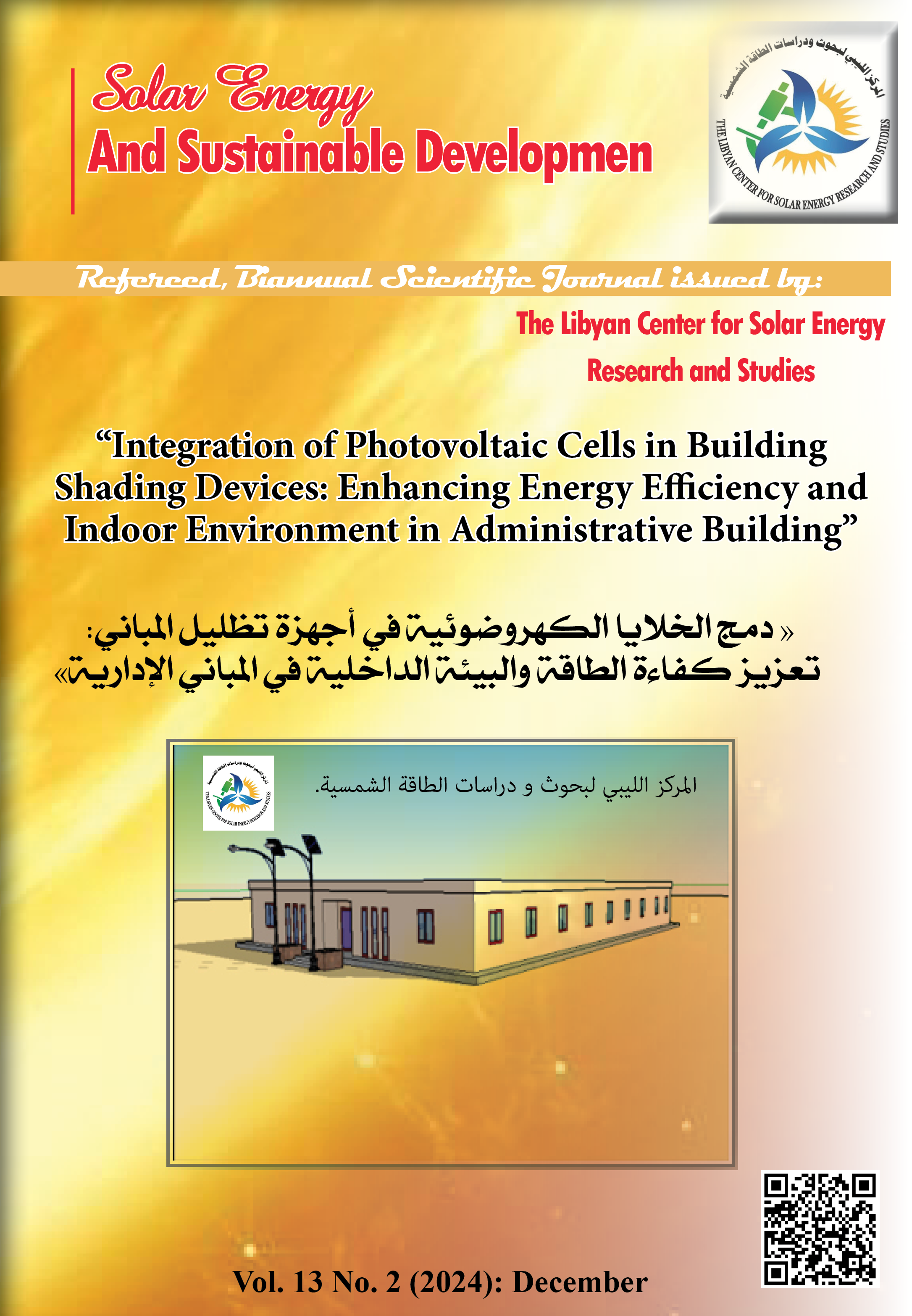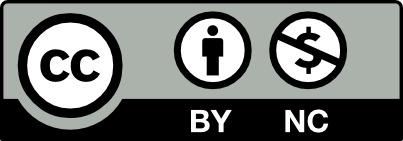Integration of Photovoltaic Cells in Building Shading Devices:
Enhancing Energy Efficiency and Indoor Environment in Administrative Building
DOI:
https://doi.org/10.51646/jsesd.v13i2.230Keywords:
Photovoltaic cells, shading devices, indoor environment, SketchUp, EnergyPlus, thermal insulation.Abstract
This study focuses on the thermal performance simulation of the CSERS administrative building. It proposed the integration of shading elements on the south façade of the building to enhance thermal comfort for office occupants. These shading elements incorporate photovoltaic cells, displaying the potential of utilizing photovoltaic in external shading devices. The main objective of this approach is effectively address issues related to high internal temperatures and excessive solar radiation exposure. Furthermore, it ensures the preservation of key functions of the building envelope, such as thermal insulation, provision of natural lighting, and prevention of internal thermal glare. Comparative analysis is conducted between the building equipped with shading devices and the one without, with a focus on measuring the total electrical energy generated by the photovoltaic panels. Simulation programs such as SketchUp and EnergyPlus are utilized for this purpose. The results of the simulations reveal that strategically designed shading on south-facing windows leads to 17.15% reduction in annual heat gains transmitted to the building. In addition, the integration of photovoltaic shading devices demonstrates outstanding performance characteristics, contributing a productive capacity of around 5916.388 MW/h to the building. This integration effectively harnesses solar energy to improve the indoor environment of the building.
Downloads
Metrics
References
Aboud, N. (2021). Analysis on thermal performance for increasing energy effiency: A case study for Tripoli-Libya, using Ecotect®. Solar Energy and Sustainable Development Journal, 10(1), 20-33. DOI: https://doi.org/10.51646/jsesd.v10i1.22
Abdunnabi, M., Belgasim, B., BenAbead, M., & Mohamed, F. (2020, October). Performance analysis of solar heat generation system for multi-purpose applications. In 2020 11th International Renewable Energy Congress (IREC) (pp. 1-5). IEEE. DOI: https://doi.org/10.1109/IREC48820.2020.9310438
De Carvalho Lucarelli, C., Carlo, J. C., & Martínez, A. C. P. (2019). Parameterization and solar radiation simulation for optimization of a modular canopy. PARC Pesquisa em Arquitetura e Construção, 10, e019017-e019017. DOI: https://doi.org/10.20396/parc.v10i0.8653371
(Outlook, W. E. (2015). Energy Climate andChange. WEO2015. https://www.waujpas.com/index.php/journal/article/view/35/19
Tawil, I., Abeid, M., Abraheem, E., Alghoul, S., & Dekam, E. (2018). Review on solar space heating-cooling in Libyan residential buildings. Solar Energy and Sustainable Development Journal, 7(SI), 78-112. DOI: https://doi.org/10.51646/jsesd.v7iSI.76
Sohani, A., Cornaro, C., Shahverdian, M. H., Pierro, M., Moser, D., Nižetić, S., ... &Doranehgard, M. H. (2023). Building integrated photovoltaic/thermal technologies in Middle Eastern and North African countries: Current trends and future perspectives. Renewable and Sustainable Energy Reviews, 182, 113370. DOI: https://doi.org/10.1016/j.rser.2023.113370
Chen, T., An, Y., & Heng, C. K. (2022). A review of building-integrated photovoltaics in Singapore: Status, barriers, and prospects. Sustainability, 14(16), 10160. DOI: https://doi.org/10.3390/su141610160
Asan, H. (2000). Investigation of wall's optimum insulation position from maximum time lag and minimum decrement factor point of view. energy and buildings, 32(2), 197-203. DOI: https://doi.org/10.1016/S0378-7788(00)00044-X
Asan, H., & Sancaktar, Y. S. (1998). Effects of wall's thermophysical properties on time lag and decrement factor. energy and buildings, 28(2), 159-166. DOI: https://doi.org/10.1016/S0378-7788(98)00007-3
Al-Sanea, S. A., & Zedan, M. F. (2011). Improving thermal performance of building walls by optimizing insulation layer distribution and thickness for same thermal mass. Applied Energy, 88(9), 3113-3124. DOI: https://doi.org/10.1016/j.apenergy.2011.02.036
Teyabeen, A. A., &Jwaid, A. E. (2023). Modelling, Validation, and Simulation of Solar Photovoltaic Modules. Electrica, 23(1). DOI: https://doi.org/10.5152/electrica.2022.21164
AP-75 Photovoltaic Module Datasheet. (n.d.). Manufacturer Company. Retrieved from https://www.manufacturer-website.com/ap-75-datasheet
Hafez, A. A., Nassar, Y. F., Hammdan, M. I., & Alsadi, S. Y. (2020). Technical and economic feasibility of utility-scale solar energy conversion systems in Saudi Arabia. Iranian Journal of Science and Technology, Transactions of Electrical Engineering, 44, 213-225. DOI: https://doi.org/10.1007/s40998-019-00233-3
Nassar, Y. F., & Salem, A. A. (2007). The reliability of the photovoltaic utilization in southern cities of Libya. Desalination, 209(1-3), 86-90. DOI: https://doi.org/10.1016/j.desal.2007.04.013
Brackney, L., Parker, A., Macumber, D., & Benne, K. (2018). Building energy modeling with OpenStudio. New York: Springer International Publishing. DOI: https://doi.org/10.1007/978-3-319-77809-9
Standard, A. S. H. R. A. E. (1992). Thermal environmental conditions for human occupancy. ANSI/ASHRAE, 55, 5.
Hammad, F., & Abu-Hijleh, B. (2010). The energy savings potential of using dynamic external louvers in an office building. Energy and Buildings, 42(10), 1888-1895. DOI: https://doi.org/10.1016/j.enbuild.2010.05.024
Palmero-Marrero, A. I., & Oliveira, A. C. (2010). Effect of louver shading devices on building energy requirements. Applied energy, 87(6), 2040-2049. DOI: https://doi.org/10.1016/j.apenergy.2009.11.020
Gutierrez, G. C. R., & Labaki, L. C. (2007). An experimental study of shading devices: orientation typology and material. Thermal Performance of Exterior Envelopes of Whole Buildings X.
Umbark, M. A., Alghoul, S. K., & Dekam, E. I. (2020). Energy consumption in residential buildings: Comparison between three different building styles. Sustainable Development Research, 2(1), p1-p1. DOI: https://doi.org/10.30560/sdr.v2n1p1

Downloads
Published
How to Cite
Issue
Section
License

This work is licensed under a Creative Commons Attribution-NonCommercial 4.0 International License.













